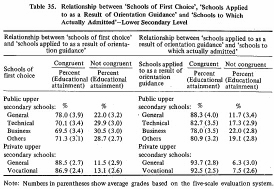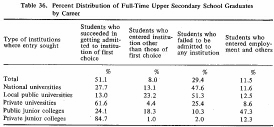| Home > Policy > White Paper, Notice, Announcement > White Paper > EDUCATIONAL STANDARDS IN JAPAN 1971 > CHAPTER |
||
According to the results of the 'Survey on the Academic and Occupational Careers of School Graduates' conducted in 1968, 77% of the lower secondary school graduates went on to upper secondary schools, and 17% entered employment; 25% Of the Upper secondary school graduates went on to higher educational institutions, and 56% of them entered employment; while 6% of the lower secondary school graduates and 19% of the upper secondary school graduates failed either to be admitted to higher level educational institutions or to find employment.
Of lower secondary school graduates who went on to upper secondary schools, 24% applied for admission to schools not of their first choice and 14% went on to schools other than those chosen as a result of orientation guidance.

Note: Numbers in parentheses show average grades based on the five-scale evaluation system.
Of those upper secondary school graduates who wished to go on to institutions of higher learning, only 51% succeeded in getting admitted to the universities or junior colleges of their first choice, 29% failed to be admitted to any institution, and 12% did not apply for admission to higher educational institutions and either entered employment or remained unemployed.

According to a study conducted by the Ministry of Labor, more than half of lower and upper secondary school students who graduated and entered employment in l966left their first job within three years after graduation.

This situation suggests that orientation and vocational guidance activities should be further improved and expanded in lower and upper secondary schools.
| Back to Top | MEXT HOME |